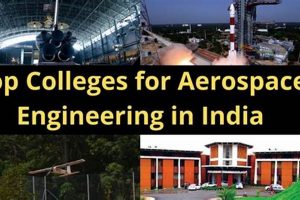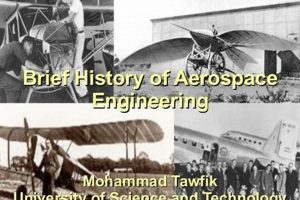The acquisition of knowledge and skills in the design, development, and testing of aircraft and spacecraft can now be achieved through remote education. This educational model provides curricula traditionally delivered in a physical classroom setting through online platforms. For instance, individuals in remote locations or those with scheduling constraints can pursue a formal education in this discipline without relocating to a university campus.
The availability of remote educational opportunities in this field significantly broadens access to specialized knowledge. It allows individuals to upskill or reskill while maintaining their current employment or other commitments. Historically, such specialized education was limited to those with the resources and ability to attend on-site programs. The shift toward remote delivery democratizes access and supports a more diverse student body, contributing to innovation within the aerospace sector by drawing talent from various backgrounds and geographical locations.
The following discussion will explore the specific curricula available through these programs, the technologies used to deliver the content, the accreditation and recognition of such qualifications, and the career pathways available to graduates. This includes a look at the challenges and opportunities presented by this mode of instruction, comparing it to traditional on-campus programs, and considering future trends.
Essential Guidance for Remote Aerospace Education
Engaging in the remote study of aerospace engineering requires a strategic approach to maximize learning outcomes and professional development. The following provides essential guidance for individuals pursuing this academic path.
Tip 1: Establish a Dedicated Learning Environment: Designate a specific, quiet space solely for academic pursuits. This helps create a mental separation between work or personal life and study, improving focus and retention of information.
Tip 2: Prioritize Time Management and Scheduling: Develop a structured schedule that allocates specific time blocks for lectures, assignments, and self-study. Adhere to the schedule as closely as possible to maintain momentum and avoid falling behind on course material. Consider using digital calendars or planning tools to stay organized.
Tip 3: Actively Participate in Online Forums and Discussions: Engage with instructors and fellow students through online forums and discussion boards. This fosters a collaborative learning environment and allows for the exchange of ideas, clarifying concepts, and expanding understanding of the subject matter.
Tip 4: Leverage Available Technological Resources: Become proficient in using the software and platforms employed by the institution for course delivery, simulations, and research. Familiarize yourself with tools used in the aerospace industry to bridge the gap between theoretical knowledge and practical application.
Tip 5: Seek Out Mentorship and Networking Opportunities: Actively seek out mentorship opportunities from experienced professionals in the aerospace field. Attend virtual industry events and conferences to network with peers and potential employers. Building a professional network can provide valuable insights and career advancement opportunities.
Tip 6: Maintain Consistent Communication with Instructors: Regularly communicate with instructors to clarify any doubts or seek guidance on challenging concepts. Proactive communication ensures that potential learning gaps are addressed promptly, maximizing the effectiveness of the educational experience.
Tip 7: Emphasize Practical Application Through Projects and Simulations: Supplement theoretical knowledge with hands-on projects and simulations whenever possible. This reinforces understanding and develops practical skills relevant to the aerospace industry. Explore open-source projects or design challenges to further enhance practical abilities.
These considerations are crucial for achieving success in aerospace engineering studies delivered remotely. They require self-discipline, resourcefulness, and a proactive approach to learning. Applying these tips can significantly enhance the educational experience and improve career prospects.
The following sections will delve into the specific challenges and opportunities associated with career paths following remote aerospace engineering education.
1. Accessibility Expansion
Accessibility expansion, in the context of remote aerospace engineering education, represents a paradigm shift in the dissemination of specialized knowledge. It transcends geographical limitations and conventional barriers to entry, thereby democratizing access to a field historically constrained by institutional exclusivity.
- Geographic Reach
Remote learning eliminates the need for physical relocation to attend on-campus programs. This enables individuals in remote areas or those with limited mobility to pursue aerospace engineering education. For example, students in developing nations with limited access to specialized universities can now access courses from institutions worldwide, broadening their educational opportunities. This expands the talent pool and fosters global collaboration within the aerospace sector.
- Socioeconomic Inclusivity
Online programs often have lower tuition fees and eliminate the costs associated with on-campus living, such as accommodation and commuting. This makes aerospace engineering education more financially accessible to students from diverse socioeconomic backgrounds. Scholarships and financial aid programs specifically designed for online learners further enhance this inclusivity, enabling individuals who might otherwise be excluded from pursuing higher education in this field.
- Flexibility and Time Management
Remote education provides flexibility in scheduling and pacing, allowing students to balance their studies with work, family, or other commitments. This is particularly beneficial for working professionals seeking to upskill or reskill in aerospace engineering. Self-paced learning modules and asynchronous lectures enable students to learn at their own speed, accommodating individual learning styles and preferences.
- Increased Enrollment Opportunities
Many established universities now offer remote programs that allow more students to attend school which provides career advancement in a more broad capacity. The removal of physical space constraints allows institutions to accept a larger number of qualified applicants, increasing overall enrollment and expanding access to specialized aerospace engineering education.
These facets collectively illustrate the profound impact of accessibility expansion on the field of aerospace engineering. Through the removal of geographical, socioeconomic, and temporal barriers, remote education empowers a more diverse and globally distributed student body to contribute to the advancement of aerospace technology and innovation. This transformation fosters a more inclusive and dynamic aerospace workforce.
2. Curriculum Fidelity
Curriculum fidelity, in the context of aerospace engineering distance learning, is the extent to which the online educational program accurately replicates the content, rigor, and learning outcomes of its on-campus counterpart. It is a critical factor determining the credibility and value of remote aerospace engineering qualifications. A direct causal relationship exists: higher curriculum fidelity results in graduates with comparable skill sets and knowledge bases to those from traditional programs. The importance of curriculum fidelity stems from the need to maintain industry standards and ensure that graduates are prepared to meet the demands of the aerospace engineering profession. For instance, if a remote course omits essential topics such as advanced materials or flight dynamics, the graduate’s ability to perform effectively in roles requiring these skills is compromised.
The achievement of curriculum fidelity in distance learning involves several key considerations. One is the careful translation of hands-on laboratory experiences into virtual simulations or remote labs, where students can conduct experiments and analyze data. This requires leveraging advanced software and hardware to replicate the physical environment of a traditional lab. Another consideration is the quality of online instructional materials, which must be designed to engage students and facilitate active learning. Interactive simulations, multimedia presentations, and collaborative projects can enhance the learning experience and promote a deeper understanding of complex concepts. Assessments must also be aligned with the curriculum and designed to measure students’ mastery of key learning objectives. Examples include online quizzes, written assignments, and virtual design projects that require students to apply their knowledge to solve real-world aerospace engineering problems.
In conclusion, curriculum fidelity is a cornerstone of effective aerospace engineering distance learning. It ensures that remote programs provide students with a high-quality education that is comparable to traditional on-campus programs. Maintaining curriculum fidelity requires careful attention to the design and delivery of online instruction, the integration of virtual laboratory experiences, and the use of rigorous assessment methods. Addressing these challenges is crucial for ensuring that graduates of remote aerospace engineering programs are well-prepared to contribute to the advancement of the aerospace industry.
3. Technology Integration
The successful implementation of aerospace engineering distance learning relies heavily on technology integration. This integration is not merely the digitization of traditional materials but a comprehensive restructuring of educational delivery to leverage digital tools and platforms. Technology integration is the linchpin that enables effective remote instruction, simulates real-world experiences, and facilitates collaboration among students and instructors.
- Advanced Simulation Software
Sophisticated simulation software is essential for aerospace engineering students to design, test, and analyze complex systems virtually. These tools allow students to model aerodynamic forces, structural behavior, and control systems without the need for physical prototypes. For example, Computational Fluid Dynamics (CFD) software enables the simulation of airflow around aircraft wings, providing valuable insights into aerodynamic performance. Finite Element Analysis (FEA) software allows for the analysis of stress and strain in aerospace structures. The use of such software allows students to gain practical experience and develop crucial skills in analysis and design.
- Virtual Laboratories
Virtual laboratories provide remote access to experiments and equipment that would otherwise be unavailable. These labs use simulations and remote-controlled hardware to replicate the hands-on experience of a physical laboratory. For example, a virtual wind tunnel allows students to conduct aerodynamic experiments and collect data remotely. A virtual avionics lab enables students to test and troubleshoot electronic circuits and systems. These simulations and remote hardware enable practical learning in a virtual environment, replicating essential components of hands-on experimentation.
- Collaboration Platforms
Collaboration platforms facilitate communication and teamwork among students and instructors. These platforms provide tools for online discussions, project management, and document sharing. For example, virtual project rooms allow students to work together on design projects, sharing ideas and coordinating tasks. Online discussion forums enable students to ask questions and receive feedback from instructors and peers. These tools support a collaborative learning environment and replicate the team-based nature of the aerospace engineering profession.
- Learning Management Systems (LMS)
Learning Management Systems (LMS) serve as the central hub for course content, assignments, and assessments. These systems provide a structured environment for delivering educational materials and tracking student progress. For example, an LMS can host video lectures, reading materials, and interactive quizzes. It can also facilitate the submission of assignments and the delivery of grades. By providing a structured environment the LMS supports the organization and administration of remote aerospace engineering education.
In summary, technology integration is fundamental to aerospace engineering distance learning. Advanced simulation software, virtual laboratories, collaboration platforms, and Learning Management Systems (LMS) are essential elements of this integration. These technologies collectively support effective remote instruction, provide practical experience, and foster collaboration. They enable aerospace engineering distance learning programs to deliver high-quality education and prepare students for successful careers in the aerospace industry.
4. Accreditation Validity
Accreditation validity is paramount to the credibility and recognition of aerospace engineering distance learning programs. It serves as an external validation of the program’s quality, ensuring adherence to established educational standards and industry benchmarks. Accreditation, conferred by recognized agencies, signifies that the curriculum, faculty qualifications, and resources meet specific criteria deemed essential for producing competent aerospace engineers. A direct consequence of valid accreditation is enhanced employability for graduates, as employers often prioritize candidates from accredited programs. For instance, the Accreditation Board for Engineering and Technology (ABET) is a prominent accrediting body for engineering programs in the United States; its accreditation provides assurance to employers that graduates have received a rigorous and comprehensive education.
The absence of valid accreditation can severely limit career prospects for graduates of aerospace engineering distance learning programs. Employers may question the program’s quality and the graduate’s competency, leading to fewer job opportunities and lower starting salaries. Furthermore, graduates of non-accredited programs may face challenges in pursuing advanced studies or professional licensure, such as the Professional Engineer (PE) license. The process of accreditation typically involves a rigorous self-study by the institution, followed by a site visit and review by the accrediting agency. This process ensures that the program meets the agency’s standards for curriculum content, faculty expertise, laboratory facilities, and student outcomes. Continuous monitoring and periodic re-accreditation are essential to maintain accreditation validity and ensure ongoing program improvement.
In summary, accreditation validity is a non-negotiable element of aerospace engineering distance learning. It provides assurance of program quality, enhances graduate employability, and facilitates professional advancement. Prospective students should thoroughly research the accreditation status of any aerospace engineering distance learning program they are considering. Institutions offering such programs must prioritize accreditation to maintain their credibility and ensure that their graduates are well-prepared to contribute to the aerospace engineering profession. The ongoing monitoring and improvement processes associated with accreditation contribute to the overall quality and relevance of aerospace engineering education, both on-campus and online.
5. Practical Application
Effective aerospace engineering distance learning mandates a robust integration of practical application to translate theoretical knowledge into tangible skills. The absence of hands-on experience, a traditional strength of on-campus programs, presents a significant challenge that must be addressed through alternative methodologies. The incorporation of simulations, virtual laboratories, and collaborative projects serves to bridge the gap between abstract concepts and real-world engineering challenges. For example, students may engage in virtual design projects, such as designing an aircraft wing or simulating the trajectory of a satellite. These activities require the application of learned principles to solve practical problems, thereby reinforcing understanding and building problem-solving abilities. A causal relationship exists between the extent and quality of practical application and the preparedness of graduates for the demands of the aerospace industry. Programs that prioritize practical experience through these methodologies are more likely to produce graduates capable of contributing effectively to engineering teams and projects.
The use of industry-standard software and tools further enhances the practical application component of distance learning. Providing students with access to software used in the aerospace sector allows them to develop proficiency in the tools they will encounter in their professional careers. For instance, instruction in CAD software enables students to create and modify engineering designs. Similarly, exposure to simulation and analysis software allows them to evaluate the performance of these designs under various conditions. Collaborative projects, where students work together to solve complex engineering problems, simulate the team-based environment of the aerospace industry. These experiences provide valuable opportunities for students to develop communication, coordination, and problem-solving skills. The effectiveness of these approaches is directly tied to their realism and the extent to which they mirror actual engineering practices.
In summary, practical application is an indispensable component of aerospace engineering distance learning, mitigating the limitations of remote instruction and ensuring that graduates are equipped with the skills necessary for success. Simulation software, virtual labs, industry tools, and collaborative projects constitute essential elements of a robust practical application strategy. While challenges remain in replicating the full range of hands-on experiences available in traditional programs, the conscientious integration of these methodologies can significantly enhance the educational value and career readiness of graduates. The continued development and refinement of these techniques will be critical for the ongoing success and acceptance of distance learning in the field of aerospace engineering.
Frequently Asked Questions About Aerospace Engineering Distance Learning
The following addresses common inquiries regarding the pursuit of aerospace engineering education through remote learning platforms.
Question 1: Is a degree earned through aerospace engineering distance learning considered equivalent to an on-campus degree by employers?
The perceived equivalence of a distance learning degree hinges on accreditation. If the program holds accreditation from a recognized body such as ABET, employers generally view the degree as comparable to an on-campus degree. Accreditation signifies adherence to established academic standards and rigor.
Question 2: What are the specific technological requirements for participating in aerospace engineering distance learning?
Technological requirements typically include a reliable high-speed internet connection, a computer meeting minimum specifications for running engineering software (e.g., CAD, FEA), and access to necessary communication and collaboration tools as stipulated by the program. Specific software licenses may also be required.
Question 3: How is practical experience, such as laboratory work, incorporated into aerospace engineering distance learning programs?
Practical experience is commonly facilitated through virtual laboratories, simulations, and remote access to physical equipment. These methodologies aim to replicate hands-on experiences and provide students with opportunities to apply theoretical knowledge in a practical context.
Question 4: What are the career prospects for graduates of aerospace engineering distance learning programs?
Career prospects are largely dependent on the program’s accreditation, the graduate’s acquired skills, and the prevailing job market conditions. Graduates can pursue various roles in design, research, development, and testing within the aerospace industry, provided they possess the requisite skills and knowledge.
Question 5: How does the cost of aerospace engineering distance learning compare to traditional on-campus programs?
The cost can vary. While tuition fees may be similar, distance learning often eliminates expenses associated with on-campus housing, commuting, and other related costs. The overall financial burden may therefore be lower for distance learning programs.
Question 6: What support services are available to students enrolled in aerospace engineering distance learning programs?
Support services typically include online tutoring, access to digital libraries, technical support for software and hardware issues, and virtual advising services. The availability and quality of these services can vary between institutions.
In summation, aerospace engineering distance learning offers a viable pathway to acquiring aerospace engineering education, provided that prospective students carefully evaluate program accreditation, technological requirements, practical application components, and available support services. Success in this mode of learning necessitates self-discipline, effective time management, and proactive engagement with the available resources.
The following sections will explore the trends, predictions and future perspectives of Aerospace Engineering Distance Learning.
Conclusion
Aerospace engineering distance learning provides an avenue for individuals to acquire specialized knowledge and skills without the constraints of traditional on-campus education. Throughout this exploration, the importance of accreditation, curriculum fidelity, technology integration, and practical application has been emphasized. The validity and acceptance of qualifications obtained through this mode of learning are intrinsically linked to adherence to these critical factors. Accessible remote aerospace education broadens career prospects within the aerospace industry.
The ongoing evolution of digital technologies and pedagogical approaches will continue to shape the landscape of remote learning. Prospective students should carefully evaluate programs based on accreditation, curriculum, and support services to ensure that their educational goals align with industry demands. The future of aerospace engineering education increasingly incorporates remote learning as a viable and essential pathway for professional development.







